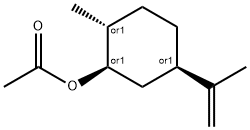Amyl acetate , AR,99.0% , 628-63-7
Synonym(s):
Amyl acetate;n-Amyl acetate;Pear oil, n-Pentyl acetate, Acetic acid pentyl ester;Pentyl acetate
CAS NO.:628-63-7
Empirical Formula: C7H14O2
Molecular Weight: 130.18
MDL number: MFCD00009500
EINECS: 211-047-3
PRODUCT Properties
| Melting point: | −100 °C(lit.) |
| Boiling point: | 142-149 °C(lit.) |
| Density | 0.876 g/mL at 25 °C(lit.) |
| vapor density | 4.5 (vs air) |
| vapor pressure | 4 mm Hg ( 20 °C) |
| refractive index | n |
| Flash point: | 75 °F |
| storage temp. | Store below +30°C. |
| solubility | 10g/l |
| form | Powder |
| color | White |
| Odor | Pleasant banana-like; mild; characteristic banana- or pear-like odor. |
| explosive limit | 1.1-7.5%(V) |
| biological source | synthetic |
| Odor Type | fruity |
| Water Solubility | 10 g/L (20 ºC) |
| FreezingPoint | -70.8℃ |
| BRN | 1744753 |
| Henry's Law Constant | 10.73 at 37 °C (static headspace-GC, Bylaite et al., 2004) |
| Exposure limits | TLV-TWA 100 ppm (~525 mg/m3) (ACGIH,
MSHA, and OSHA); IDLH 4000 ppm. |
| Dielectric constant | 5.0(20℃) |
| LogP | 2.300 |
| Surface tension | 25.8mN/m at 298.15K |
| CAS DataBase Reference | 628-63-7(CAS DataBase Reference) |
| NIST Chemistry Reference | Acetic acid, pentyl ester(628-63-7) |
| EPA Substance Registry System | n-Amyl acetate (628-63-7) |
Description and Uses
All isomers of amyl acetate are highly flammable, colorless to yellow, watery liquids. The n- and isoisomers have a persistent, fruity, banana-like or pear-likeodor. The sec-isomer has a mild fruity odor. Molecularweight of isomers 5 130.21. Hazard Identification (basedon NFPA-704 M Rating System): (sec-isomer) Health 2,Flammability 3, Reactivity 0.n-isomer: Boiling point= 121℃; Melting/Freezingpoint=2 72℃; Specific gravity= 0.876 at 20℃; Liquidsurface tension= 5 0.012 N/m at 30℃; Liquid water interfacial tension 5 (estimate) 0.05 N/m at 17℃; Relative vapordensity (air= 1) 5 4.5; Ratio of specific heats of vapor(gas) 5 1.1; Latent heat of vaporization= 3.1 3 105 J/kg;Heat of combustion 5 2 310.8 3 105 J/kg; Vaporpressure= 0.93 kPa at 20℃; Flash point= 16°21℃, 25℃(cc); Autoignition temperature= 360℃; Explosive limits:LEL 5 1.0%; UEL 5 7.5%; Odorthreshold 5 0.0075°7.3 ppm.sec-isomer: Boiling point= 121℃; Melting/Freezingpoint=2 148℃; Critical temperature= 326℃; Criticalpressure= 411.6 psia 5 28.0 atm 5 2.83 MN/m2; Specificgravity= 0.861°0.866 at 20℃; Liquid surface tension 5 28.9 dynes/cm 5 0.0289 N/m at 20℃; Liquidwater interfacial tension 5 (estimate) 0.0441 N/m at20℃; Relative vapor density (air= 1) 5 4.5; Ratio of specific heats of vapor (gas) 5 (estimate).1°1.1 at 20℃;Latent heat of vaporization= (estimate) 5 3.0 3 105 J/kg;Heat of combustion 5 2 14.402 Btu/lb 5 2 8000cal/g 5 2 334.9 3 105 J/kg; Vapor pressure= 7 mmHg at20℃; Flash point= 32℃; Explosive limits: LEL 5 1.1%;UEL 5 7.0%; Odor threshold 5 0.002 ppm.tert-isomer: Boiling point= 125℃; Flash point= 26℃;Explosive limits: LEL 5 1.0%; UEL 5 7.5%; Odor threshold 5 0.08 *0.0006 in water.iso-isomer: Boiling point= 142℃; Melting/Freezingpoint=2 78.5℃; Critical temperature 326.1℃; Criticalpressure= 2.84 MN/m2; Specific gravity= 0.876 at 15℃;Liquid surface tension= 5 0.02477 N/m at 20℃; Liquid waterinterfacial tension5 0.0502 N/m at 15℃; Relative vapor density (air= 1) 5 4.5; Ratio of specific heats of vapor (gas) 5(estimate).1°1.1; Latent heat of vaporization= (estimate) 53.07 3 105 J/kg; Heat of combustion 5 2 334.9 3 105 J/kg;Vapor pressure= 4 mmHg at 20℃; Autoignitiontemperature5 379℃; Flash point= 25℃; Autoignitiontemperature5 379℃; Explosive limits: LEL5 1.2% at 100℃;UEL 5 7.5%; Odor threshold 5 0.015.They all float on water and have poor (slight to negligible)solubility. Water contact forms a flammable, irritatingvapor. Hazard Identification (based on NFPA-704 M RatingSystem): Health 1, Flammability 3, Reactivity 0.*The range of accepted odor threshold values is quite broadand caution should be used in relying on odor alone as awarning of potentially hazardous exposure.
Banana essence. Used as test odorant in studies of olfactory function and in studies of the psychosocial effects of odor.
Safety
| Symbol(GHS) |  GHS02 |
| Signal word | Warning |
| Hazard statements | H226 |
| Precautionary statements | P210-P233-P240-P241-P242-P243 |
| Hazard Codes | Xi |
| Risk Statements | 10-66 |
| Safety Statements | 23-25-24/25 |
| RIDADR | UN 1104 3/PG 3 |
| OEB | A |
| OEL | TWA: 100 ppm (525 mg/m3) |
| WGK Germany | 3 |
| RTECS | AJ1925000 |
| F | 21 |
| Autoignition Temperature | 680 °F &_& 714 °F |
| TSCA | Yes |
| HazardClass | 3 |
| PackingGroup | III |
| HS Code | 29153930 |
| Hazardous Substances Data | 628-63-7(Hazardous Substances Data) |
| Toxicity | Acute oral LD50 for rats 6,500 mg/kg (quoted, RTECS, 1985). |
| IDLA | 1,000 ppm |



